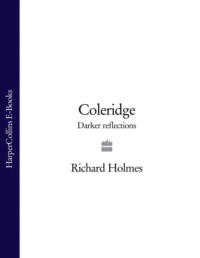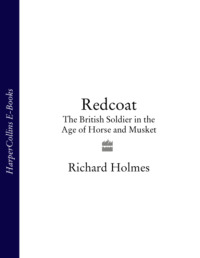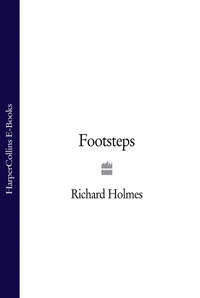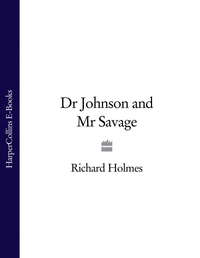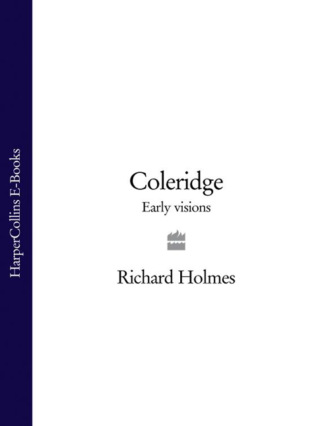
Полная версия
Coleridge: Early Visions
6
He was petted by his sister Nancy, who used to sing him melancholy ballads on winter evenings:
Ballad of ship-wreck’d sailor floating dead, Whom his own true-love buried in the sands!14
But he was teased by the older schoolboys, and sibling rivalry soon surfaced with his daring, extrovert brother Francis. There were angry disputes for the affection of his nurse, Molly, an old family retainer, much loved by all the other boys. In the autobiographical letters written at Nether Stowey in his twenties,* Coleridge analysed this with his customary psychological acuity, finding in it the beginnings of his inner imaginative life, a child escaping into his fantasy world.
Molly, who had nursed my Brother Francis, and was immoderately fond of him, hated me because my mother took more notice of me than of Frank – and Frank hated me, because my mother gave me now & then a bit of cake, when he had none…So I became fretful, & timorous, & a tell-tale – & the School-boys drove me from play, & were always tormenting me – & hence I took no pleasure in boyish sports – but read incessantly…And I used to lie by the wall, and mope – and my spirits used to come upon me suddenly, & in a flood – & then I was accustomed to run up and down the church-yard, and act over all I had been reading on the docks, the nettles, and the rank-grass.15
The church and churchyard of St Mary Ottery, immediately outside the School House across the sunken lane, became a magic world to little Sam amidst these persecutions, mopings and tantrums. He would later strongly identify with another persecuted poet, Thomas Chatterton, who created his own imaginary world in St Mary’s Redcliffe church, at Bristol.
St Mary Ottery was an evocative place, a fourteenth-century foundation modelled by Bishop Grandisson on Exeter Cathedral, a collegiate building much larger than an ordinary parish church. It dominated the Cornhill and the entire town, with two huge granite bell-towers whose peals could be heard throughout the valley of the Otter.
Outside, the old gravestones stood at angles in the sunlight. Inside were many shadowy wonders: corbells in the shape of owls and elephants, a globe mounted with an heraldic eagle, and the medieval tombs of the Grandisson family. On one side of the nave, low enough for a child to climb on, was the tomb of the crusader, Sir Otho de Grandisson (died 1359), in helmet and chain-mail, holding his broadsword; on the other, that of his wife Lady Beatrix (died 1374), with her dogs at her feet.
In the gallery of the south transept hung Bishop Grandisson’s enormous mechanical clock, with its square wooden face painted bright blue. It showed the time with an intriguing system of planetary symbols, based on the Ptolemaic model, with a golden sun, and silver moon, and a gilded star, moving steadily round the gleaming dial of heaven. Such images sank deeply into the child’s mind, unconsciously reappearing in the great ballads written twenty years after.
The moving Moon went up the sky
And nowhere did abide:
Softly she was going up,
And a Star or two beside.16
In his autobiographic poetry Coleridge transformed his unhappy memories into an idyllic Romantic version of his “native home”. In “Frost at Midnight”, written in 1797, the bells of St Mary’s are given a thrilling, other-worldly quality, far removed from his playground miseries. The endless carillons of feast-days and fair-days, when the chimes were rung for twelve hours at a stretch, are made to promise a dream-like expansion into future happiness. He was here describing his memories as a teenage schoolboy in London, long after the “exile” from Ottery had occurred, and the poetic myth of his childhood was already being prepared for his own son, Hartley.
With unclosed lids, already had I dreamt
Of my sweet birth-place, and the old church-tower,
Whose bells, the poor man’s only music, rang
From morn to evening, all the hot Fair-day,
So sweetly, that they stirred and haunted me
With a wild pleasure, falling on mine ear
Most like articulate sounds of things to come!17
There is perhaps a hint of bitterness in the slight rhythmic dip in the third line, where Coleridge may really have been thinking of the “poor boy’s only music” at Ottery, but otherwise the verse rises with an unbroken surge of Romantic longing to the climactic outburst of syllables in the last line, “articulate sounds”, which has an almost religious force. (It is a note that Wordsworth was to explore fully in The Prelude of 1805.)
7
In reality, for little Sam the bells brought scant release. Because of his small size and difficult temperament, he was kept on at dame-school until the age of six – not to be “trusted among my Father’s School-boys”.18 By then his elder brothers, tall distant figures, were going out into the world. William left Wadham College, Oxford, and became a schoolmaster in Hackney, aged twenty-three. James – a stocky, red-faced, resolute young man – left Ottery aged sixteen, with ten guineas sewn into the back of his waistcoat, to join the ranks of the 6th Regiment of Foot; then Edward, “the Wit of the family”, left for Pembroke, Oxford.19 Coleridge significantly put down these departures to his mother’s influence in family affairs. She was, he said dispassionately, “an admirable Economist, and managed exclusively”.20 “My Father…had so little of parental ambition in him, that he had destined his children to be Blacksmiths etc, & had accomplished his intention but for my Mother’s pride & spirit of aggrandizing her family.”21
This was almost certainly untrue of the Reverend John, whose whole career showed a headmaster’s natural drive for distinction. His academic successes were renowned throughout the county. But Coleridge’s feelings for his mother were to become ambiguous, and finally bitter. By comparison his father – his lost, beloved father – was to be transformed into a humorous paragon of gentleness and understanding, utterly without worldly ambitions.
During these difficult childhood years, after being the “darling” who sat, as he fondly recalled, “at my mother’s side, on my little stool, to read my little book, and to listen to the talk of my elders”, he clearly felt he became at first an anxiety, and then a disappointment, to her.22 He felt this rejection as deeply as anything in his life, and at sixteen would say of the mother of a schoolfriend in London that she “taught me what it was to have a mother”.23 In later life, he often repeated this sense of looking for mother-substitutes. At twenty-nine, he told his friend Tom Poole that Mrs Poole “was the only Being whom I ever felt in the relation of Mother”.24 In middle age the search for a lost mother continued, with strange consequences.25
Exactly how this process of alienation occurred is difficult to say, for Coleridge wrote and talked more and more about his father, and less and less about his mother as he grew older. But he seems to have felt, very early on, that in her eyes by comparison with his brothers, he was already a failure by the time he left Ottery. There are no contemporary accounts of mother and son together in these early days. But some years later, when he revisited Ottery in the autumn of 1799, there was a revealing incident which was recorded by his friend, Robert Southey. “We were all a good deal amused by the old lady,” – Ann Coleridge, aged seventy-two, was by then rather deaf – “she could not hear what was going on, but seeing Samuel arguing with his brothers, took it for granted that he must have been in the wrong, and cried out, ‘Ah, if your poor father had been alive, he’d soon have convinced you.’”26
It was amusing to Southey, but not to Coleridge. In his poetry it was to produce the recurring image of a lost or rejected child, for ever attempting to return home, or recover the feelings of home, or somehow – marvellously – to reinvent them.
The pluck and determination of his older brothers was exemplified by John, who had been in Calcutta since 1771, and within five years rose to the rank of lieutenant. His courage and generosity became legendary in the family. His vivid, good-hearted letters arrived regularly at Ottery throughout Coleridge’s boyhood, often bringing money. They could hardly have failed to fire Sam’s imagination. In 1775 a typical missive arrived from Monghyr, on the Ganges, a hundred miles south of the Nepalese border.
I left Calcutta about the end of April…You have no doubt heard of Monghyr, famous for its wild, romantic situation, and especially for its being the Montpellier of the East. About two miles from the garrison there is a Hotwell in which the water continually boils; the Natives esteem it sacred, and flock thither from all parts of the country to receive a Holy Sprinkling, as they imagine it has the Virtue of cleansing them from their sins…27
It may have been glimpses like this that first turned Coleridge towards his lifelong fascination with travel books. James came to rely on John for help in his own military career, eventually receiving from him the sum of £1,000 to purchase a commission. Francis so worshipped John that he finally contrived to join him in India at the incredibly early age of twelve. John even had a remarkable plan for Sam to join him in India as a cadet; but this was to be forestalled by his own tragic death from malaria, at Tillicherry, in January 1787. He died penniless, having sent all his money home or lent it to fellow officers.28
8
By the age of six, Sam’s obsessive reading had reached unhealthy proportions. Coleridge again described this with a keen eye on the young prodigy in the making. He had imported “all the gilt-covered little books” from his aunt’s every-thing shop at Crediton, and among them The Arabian Nights:
one tale of which (the tale of a man who was compelled to seek for a pure virgin) made so deep an impression on me (I had read it in the evening while my mother was mending stockings) that I was haunted by spectres, whenever I was in the dark – and I distinctly remember the anxious & fearful eagerness, with which I used to watch the window, in which the books lay – & whenever the Sun lay upon them, I would seize it, carry it by the wall, & bask, & read.29
The childish mixture of fantasy and superstition is acutely recalled: the beautiful virgin who is also a fearful spectre; the relentless moving finger of the sun which is also a kind of benevolent, protecting power. Again, these are themes that Coleridge would carry into his adult poetry of his late twenties, in “Christabel” and the Ancient Mariner.
In his forties he was still recalling the impact of The Arabian Nights in his essays: “…I can never forget with what a strange mixture of obscure dread and intense desire I used to look at the volume and watch it, till the morning sunshine had reached and nearly covered it, when, and not before, I felt the courage given me to seize the precious treasure…”30
Coleridge also saw himself as little Sam, becoming almost comically peculiar and precocious. “So I became a dreamer – and acquired an indisposition to all bodily activity – and I was fretful, and inordinately passionate, and as I could not play at any thing, and was slothful, I was despised & hated by the boys; and because I could read & spell, & had, I may truly say, a memory & understanding forced into almost an unnatural ripeness, I was flattered & wondered at by all the old women.”31 Here, incidentally, is the first glimpse of Coleridge the talker, ensconced in a circle of his clucking admirers. (He later told Godwin that he was “accustomed only to the conversation of grown persons”, and became “arrogant & conceited”.)32
The Reverend John now intervened. With characteristic forthrightness he actually burnt the offending storybooks, and enrolled Sam in the King’s School where he remained a pupil to the age of nine. He soon “outstripped” all of his age. His schoolboy horizons opened, and there is evidence of much wandering about the town, and down by the River Otter, and to neighbouring houses, often in the company of Francis, with whom fraternal warfare continued. “Frank had a violent love of beating me – but whenever that was superseded by any humour or circumstance, he was always very fond of me – & used to regard me with a strange mixture of admiration & contempt – strange it was not – : for he hated books, and loved climbing, fighting, playing, & robbing orchards, to distraction.”33
One memorable trip was to the Pixies’ Parlour, a mysterious sandstone cave beneath the roots of an ancient oak tree, in a field about a mile south of the town overlooking the river. It was a place of folklore – goblins, ghosts – where Sam bravely imitated his elders by carving his initials in the shadowy recess. It was a cave that reappeared many times in his poetry, and finally became an image of his lifelong search for esoteric knowledge:
Yea, oft alone,
Piercing the long-neglected holy cave,
The haunt obscure of old Philosophy,
He bade with lifted torch its starry walls
Sparkle, as erst they sparkled to the flame
Of odorous lamps tended by Saint and Sage.34
As an undergraduate he was to go back to find those initials, entwined with those of his heroic brothers.*
Another visit was to Sir Stafford Northcote’s new country house, the Pynes, outside Ottery. Frank had fallen in love with the baronet’s daughter Maria, to whom he was later to send messages of devotion from India. But Sam was taken by a different kind of recondite beauty – the splendid, polished, Georgian spiral staircase. Years later, when trying to explain the complex structure of his essay-collection, The Friend, with its expanding themes and “interposed” lighter pieces of diversion, or “landing-places”, he suddenly recalled his first, awesome impression of the great house.
Before all other objects, I was most struck by the magnificent staircase, relieved at well proportioned intervals by spacious landing-places, this adorned with shewy plants, the next looking out on an extensive prospect through the stately window with its side panes of rich blues and saturated amber or orange tints: while from the last and highest the eye commanded the whole spiral ascent with the marbled pavement of the great hall from which it seemed to spring up as if it merely used the ground on which it rested. My readers will find no difficulty in translating these forms of the outward senses into their intellectual analogies…35
In fact Coleridge himself always had the greatest difficulty with the “architectural” structure of his prose books, as his readers found to their cost. They were to be less like solid Georgian staircases, and far more like the visionary, suspended, self-circling stairways of Piranesi’s famous engravings. Something of this seems already foreshadowed in the childhood sense – recorded with such visual accuracy – that on looking down over the banisters from the top of Northcote’s spiral stairs, the entire structure seemed independent of the ground, simply springing up above it into the air, magically and alarmingly unsupported.
Most fondly recalled of all were the endless expeditions down to the placid, rippling waters of the Otter, which meander through low red-earthed banks and shallow shingle spits, six miles down to the sea at Budleigh Salterton:
Dear native brook! where first young Poesy
Stared wildly-eager in her noontide dream!36
Paddling, paper-boat sailing, and solemn games of ducks and drakes, are all recalled in later verse. Sam also learned to swim here, a pastime he practised at home and abroad for many years, well into his middle age. The river produced the first really accomplished poem of his youth, which he wrote at the age of twenty-one, while still at university, the sonnet “To the River Otter”.
Here again, the poetic memory is far happier than those of the letters, reaching towards a more universal and perhaps more conventionally acceptable nostalgia for childhood, the Paradise lost, that the Romantics would foster. Yet it is brilliant with living detail, full of Coleridge’s sensitivity to light and movement. The rapid, effortless bouncing stone enacts the freedom of the child’s mind – the skips and flights of the imagination – while the glowing waters become a symbol of memory itself.
…What happy and what mournful hours, since last
I skimm’d the smooth thin stone along thy breast,
Numbering its light leaps! yet so deep imprest
Sink the sweet scenes of childhood, that mine eyes I never shut amid the sunny ray,
But straight with all their tints thy waters rise, Thy crossing plank, thy marge with willows grey,
And bedded sand that vein’d with various dyes
Gleam’d through thy bright transparence!…Ah! that once more I were a careless Child!37
9
In his first year at the King’s School (1779) an epidemic swept through the pupils, and both Sam and George lay dangerously ill isolated at the top of the School House with “putrid fever”. This is the first time that Coleridge experienced the terrible nightmares that returned to him intermittently for the rest of his life, dreams so vivid and overmastering that he would wake whole households at Stowey, at Grasmere, and even at Highgate with his screams, and which are the subject – and indeed the inspiration – of many poems. Even as a boy he tried to keep them off with a poetic charm, the old rhyming prayer, “Four Angels round me spread, Two at my foot & two at my head…”
It was to give him a lifelong sympathy not only with other children suffering night terrors, but with any adult friend on a feverish sickbed, to many of whom he would prove a tender nurse. “This prayer I said nightly – & most firmly believed the truth of it. – Frequently have I, half-awake & half-asleep, my body diseased & fevered by my imagination, seen armies of ugly Things bursting in upon me, & these four angels keeping them off.”38 The suspended condition of “half-awake & half-asleep”, with the mind floating and planing between the conscious and unconscious state, always fascinated him.
During this illness, Frank, with typical daring and “in spite of orders to the contrary”, would steal up to read Pope’s Homer to his small brother. Sam also became much closer to George, then sixteen and about to go to Oxford, a quiet, kindly, studious boy whom Coleridge would soon look on as his second father. Of the first fifty letters Coleridge is known to have written, thirty-five were to George; and the Poems of 1797 would be dedicated to him, with an epigraph from Horace, “notable among brothers for his paternal spirit”.39
He later wrote – before quarrelling with him – “My Brother George is a man of reflective mind & elegant Genius. He possesses Learning in a greater degree than any of the Family, excepting myself. His manners are grave, & hued over with a tender sadness. In his moral character he approaches every way nearer to Perfection than any man I ever yet knew – indeed, he is worth the whole family in a Lump.”40
His sister Nancy also showed great kindness at this time, and Coleridge came to idealise the brother-sister relationship: “she lov’d me dearly, and I doted on her!” To Charles Lamb, so deeply attached to his own sister Mary, he would later say in a poem of 1794 that she became his only real confidante, listening to all his “puny sorrows” and “hidden maladies”, which he poured forth “As a sick Patient in a Nurse’s arms”.41*
But in these reminiscences there is an exaggerated idealising quality, that suggests that the perfection of Nancy was really a disguised form of reproach to his real mother. John, out in India, would also make a cult of his sister, whom he had never seen, while Frank in turn idealised his old nurse, “my good, my dear, and faithful Molly”, to whom he sent money.42 Perhaps they all felt certain reservations about their mother. Yet, except for Sam, they all grew up with a marked self-confidence in personal relations. Frank would cheerfully sign a letter to Nancy, “Your affectionate and handsome brother, Francis”, adding a postscript asking if Maria Northcote was kept fully informed of his growing good looks.43
10
In the autumn of 1779, when he was seven, a quarrel took place between Sam and Frank which throws much light on the psychology of the youngest son, and which Coleridge himself shrewdly presented as a formative event. It is given more space than any other incident in the autobiographical letters to Tom Poole, and often reappears in the poetry. It began, one October evening in the kitchen of the Vicarage, in a dispute about food – and favouritism. Sam, typically demanding, had asked his mother to prepare him some special sliced cheese for toasting. Frank stole in, and minced it up “to disappoint the favourite”, and a violent fight ensued. Fifteen years later Coleridge still entered into the drama as he wrote.
I returned, saw the exploit, and in an agony of passion flew at Frank – he pretended to have been seriously hurt by my blow, flung himself on the ground, and there lay with outstretched limbs – I hung over him moaning & in a great fright – he leaped up, & with a horse-laugh gave me a severe blow in the face – I seized a knife, and was running at him, when my Mother came in and took me by the arm – I expected a flogging – & struggling from her I ran away, to a hill at the bottom of which the Otter flows – about one mile from Ottery.44
The violence of this little scene is surprising – the “dreamer” is armed with a kitchen knife – and calls into question the whole poetic image of the “careless” childhood.
Sam fled down through the gardens of the Chanter’s House to his old friend the river, going along the bank almost as far as Cadhay Bridge. Here he hid. “I distinctly remember my feelings when I saw a Mr Vaughan pass over the Bridge, at about a furlong’s distance – and how I watched the Calves in the field beyond the river.” It grew dark, and he remained there for the entire night, “a dreadful stormy night”, and a long time for a boy of seven. He said his prayers, and thought “at the same time with inward & gloomy satisfaction, how miserable my Mother must be!” Finally he went to sleep under a mass of old thorn bush cuttings, within a few yards of the water’s edge.
His mother, indeed, was “almost distracted”. She sent out first to the churchyard where he still often played, then despatched boys all round the streets; and by dark raised a general alarm. By ten o’clock half the town had turned out to search for the missing child, the Ottery town-crier was sent to the neighbouring villages, and the ponds and mill-race were dragged. The search continued throughout the night without success, and “no one went to bed”. At five in the morning Sam awoke, now frozen through, and too weak to move. “I saw the Shepherds & Workmen at a distance – & cryed but so faintly, that it was impossible to hear me 30 yards off – and there I might have lain & died – for I was now almost given over.” His saviour was Sir Stafford Northcote, the good old fox-hunting squire, and Coleridge relived the moment of his rescue with perhaps the deepest emotion of all his childhood reminiscences.
By good luck Sir Stafford Northcote, who had been out all night, resolved to make one other trial, and came so near that he heard my crying – He carried me in his arms, for near a quarter of a mile; when we met my father & Sir Stafford’s Servants. – I remember, & never shall forget, my father’s face as he looked upon me while I lay in the servant’s arms – so calm, and the tears stealing down his face: for I was the child of his old age. – My Mother, as you may suppose, was outrageous with joy…I was put to bed – & recovered in a day or so – but I was certainly injured – For I was weakly, & subject to the ague for many years after.45




